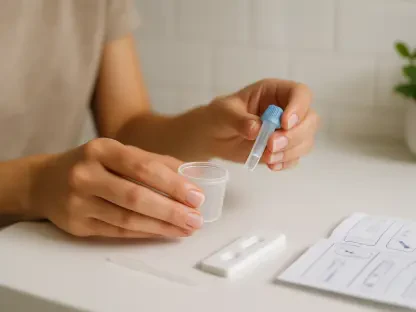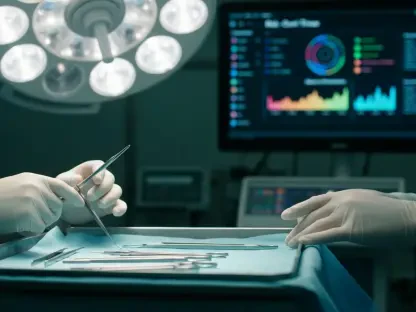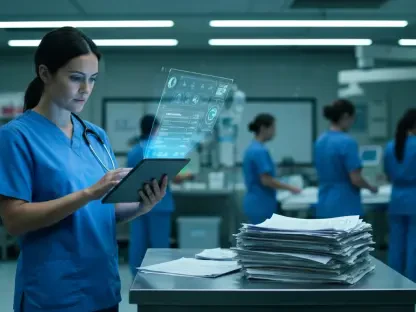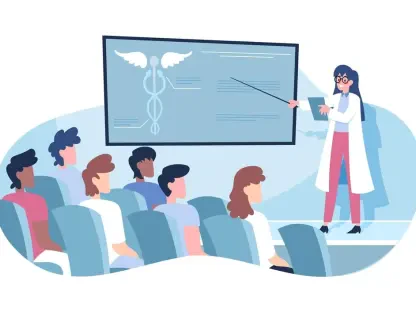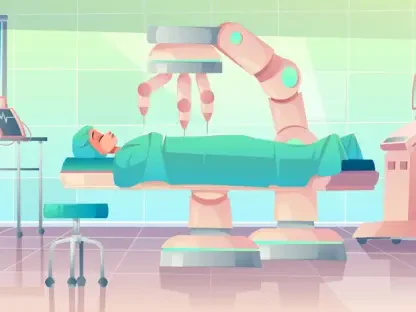Introduction to Medication Safety Challenges in Healthcare
Imagine a hospital where a single overlooked prescription could alter a patient’s life forever, a scenario that plays out far too often across the healthcare industry, costing lives and billions in damages each year. Medication safety stands as a cornerstone of patient care, yet errors remain a persistent threat, affecting millions of patients annually in the United States alone, leading to preventable harm and extended hospital stays. The stakes are high, and this pervasive issue demands urgent attention from health systems nationwide, pushing the boundaries of innovation to safeguard vulnerable populations.
The implications of these errors ripple beyond individual cases, straining resources and eroding trust in medical institutions. Near-misses, where potential errors are caught just in time, often go unreported, leaving systemic flaws unaddressed and risking future incidents. Amid this challenging landscape, the University of Arkansas for Medical Sciences (UAMS) in Little Rock has emerged as a beacon of progress, offering a compelling case study on transforming medication safety through proactive measures and cultural change.
The Good Catch Initiative at UAMS
Origins and Objectives of the Program
Before significant changes were implemented in recent years, medication error reporting at UAMS suffered from low engagement, with staff often hesitant to document issues due to inadequate systems and fear of repercussions. Reports lacked depth, providing little actionable insight to prevent future mistakes. This environment underscored a critical need for reform to protect patients from avoidable harm.
Enter Dr. Carlette Seng, who took on the role of medication safety officer at UAMS with a mission to revolutionize the approach to safety. Her vision centered on fostering a cultural shift by prioritizing “good catch reports”—instances where potential errors are identified and corrected before reaching patients. The initiative aimed to engage pharmacy staff across inpatient, outpatient, infusion, perioperative, and regional settings, leveraging their unique positions to spot risks early.
The primary objective was clear: proactively intercept errors to prevent harm while building a framework for continuous improvement. By focusing on near-misses rather than solely on incidents after they occur, the program sought to uncover hidden vulnerabilities in processes, ensuring safer care delivery across the board.
Implementation Strategies and Tools
To kickstart this transformation, UAMS adopted creative, budget-friendly tactics to encourage reporting among staff. Customized sticky notes with the program’s logo were distributed to pharmacy teams, allowing quick documentation of good catches without including sensitive patient data. These notes were then displayed on visible whiteboards in secure pharmacy areas, serving as constant reminders and showcasing peer contributions.
Technology played a pivotal role in scaling the effort, with a significant upgrade introduced in mid-2023. Following input from a front-line pharmacist, a “good catch” option was integrated into the electronic health record (EHR) system, enabling direct logging of incidents without additional paperwork. This streamlined process reduced administrative hurdles, making reporting accessible and efficient for busy professionals.
Central to these strategies was the cultivation of a just culture, where staff felt secure in reporting issues without fear of blame. Emphasis was placed on system-level solutions rather than individual fault, encouraging transparency. Regular collection and review of reports by safety officers ensured that insights translated into tangible changes, reinforcing trust in the initiative’s purpose.
Results and Impact of the Good Catch Program
Quantitative Improvements in Reporting
The impact of the Good Catch Initiative at UAMS is evident in the staggering numbers recorded over recent years. Good catch reports skyrocketed by 496.6% since the program’s early days, climbing from an average of 19.7 per month to 117.3 per month by mid-2024. This surge highlights a dramatic increase in staff awareness and willingness to document potential risks.
Beyond targeted reports, overall medication event reporting also saw an unexpected boost, rising from a modest 34 incidents in early 2023 to 93 by the start of this year. Such growth indicates broader engagement across the system. Additionally, between late 2024 and early 2025, the program identified 240 unique system opportunities, resulting in 120 implemented safety enhancements, addressing critical gaps with precision.
These figures reflect more than just numbers; they signify a shift toward proactive risk management. High-leverage interventions, such as revising order sets to prevent dangerous drug interactions during specific procedures, exemplify how data-driven changes are directly improving patient outcomes within the health system.
Qualitative Benefits and Cultural Shift
On a deeper level, the initiative has reshaped the workplace environment at UAMS by building trust among staff. Pharmacy teams now feel empowered to report errors and near-misses, knowing their input drives meaningful improvements rather than punishment. This transparency has become a cornerstone of the safety culture, breaking down long-standing barriers.
Recognition plays a vital role in sustaining momentum, with visible displays of good catches fostering a sense of community and shared purpose. Staff see their efforts acknowledged, which fuels further participation and collaboration. Peer visibility through tools like whiteboards has turned reporting into a collective achievement rather than an isolated task.
External validation from the Institute for Safe Medication Practices (ISMP) further underscores the program’s success. Praising the innovative use of simple tools and the rapid pace of system changes, ISMP has highlighted UAMS as a model for others. This recognition affirms the value of combining cultural transformation with practical solutions in tackling medication safety challenges.
Challenges and Barriers in Enhancing Medication Safety
Initially, UAMS faced significant hurdles in boosting reporting rates, as staff reluctance rooted in fear of repercussions stifled progress. Low engagement meant many near-misses went undocumented, leaving potential dangers lurking in the system. Overcoming this required persistent effort to shift mindsets and demonstrate the benefits of transparency.
Across the broader healthcare industry, similar barriers persist, including the administrative burden of reporting and resistance to cultural change. Many organizations struggle with outdated systems or policies that prioritize blame over learning, hindering efforts to improve safety. These systemic issues often discourage staff from speaking up, perpetuating cycles of risk.
UAMS addressed these obstacles by simplifying processes through EHR integration, making reporting quick and user-friendly. A non-punitive approach was emphasized, reassuring staff that the focus remained on system fixes. Such strategies offer valuable lessons for other institutions grappling with entrenched challenges in fostering a safety-first mindset.
Alignment with Industry Standards and Best Practices
The approach taken by UAMS aligns closely with recommendations from ISMP, which advocates for high-leverage interventions to prevent medication errors before they occur. By targeting systemic vulnerabilities through good catch reports, the initiative mirrors best practices that prioritize prevention over reaction, setting a strong example for compliance with safety protocols.
A just culture, as implemented at UAMS, also meets regulatory expectations by promoting accountability without fear. This framework ensures that safety reporting becomes a routine part of operations, enhancing adherence to national standards. It reflects an industry-wide push toward environments where learning from mistakes takes precedence over assigning fault.
Moreover, the model’s success suggests potential to influence broader guidelines on medication safety reporting. As health systems nationwide seek replicable solutions, the UAMS initiative could shape future policies, encouraging a shift toward proactive measures and cultural reforms that prioritize patient well-being above all.
Future Directions for Medication Safety in Healthcare
The achievements at UAMS pave the way for other health systems to adopt similar proactive safety measures, focusing on early detection of risks. By sharing lessons learned, smaller and larger institutions alike can tailor low-cost strategies to their unique needs, amplifying the impact of such initiatives across diverse settings.
Emerging trends point to increased reliance on technology, with digital tools like EHR integrations becoming central to efficient reporting. Alongside this, cultural transformation remains a priority, as fostering trust and engagement proves essential for sustainable change. These dual forces are likely to define the next wave of safety advancements in healthcare.
Looking ahead, evolving regulations, enhanced staff training, and greater patient engagement stand to further shape the landscape. As expectations tighten, health systems must adapt by investing in education and involving patients in safety conversations, ensuring a holistic approach that addresses risks from all angles over the coming years.
Conclusion
Reflecting on the journey of UAMS, the Good Catch Initiative marked a turning point in medication safety, achieving remarkable strides in reporting and system enhancements. The surge in documented near-misses and subsequent fixes showcased what is possible with dedication and innovative thinking. Beyond numbers, the cultural shift toward trust and transparency laid a foundation for lasting impact.
Moving forward, health systems should consider adopting similar low-cost, high-impact strategies, tailoring them to local contexts while prioritizing staff buy-in. Investing in technology to simplify reporting and advocating for non-punitive policies could accelerate progress. Ultimately, collaboration across the industry to share successes and challenges promises to elevate patient safety to new heights, ensuring that preventable errors become a relic of the past.


